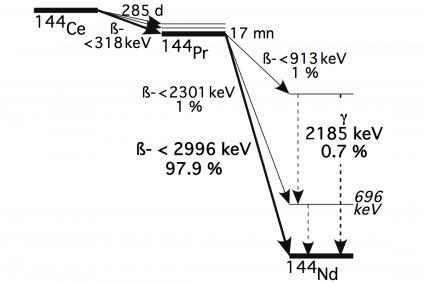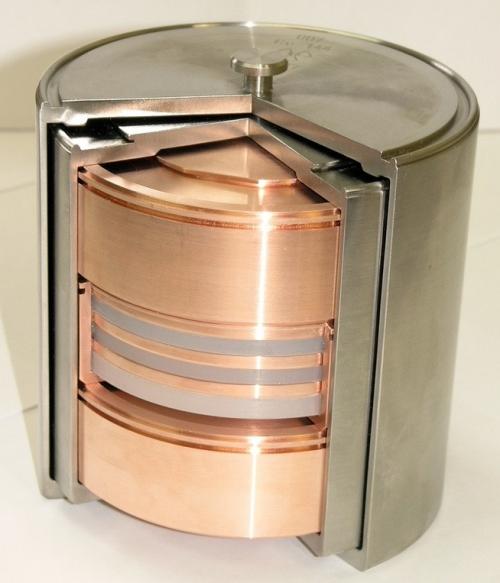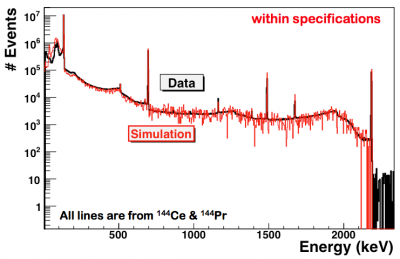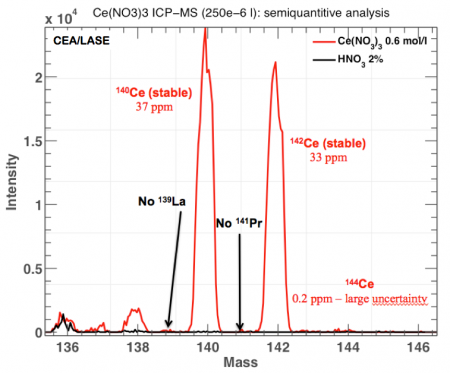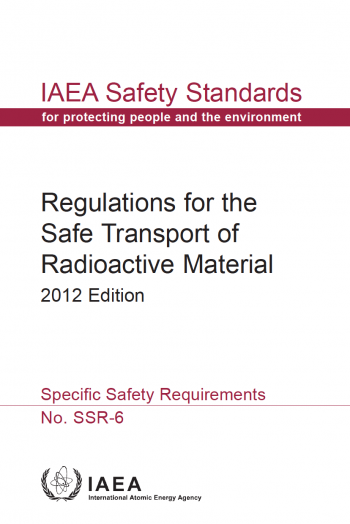For CeSOX electron antineutrinos are going to be produced by a 3-5 PBq 144Ce-144Pr radioactive source. The mean live of 144Ce is 411.01 days (1.12 year), it drives the live of its son, the 144Pr whose mean life is only 25 min. The final product is 144Nd quasi-stable (3.30 x 1015 years).
The material is in the form of compressed aggregate with a density ≈ 4-6 g/cm3. Considering 4.5 g/cm3 as a baseline its mass will be 8 kg for an initial activity of 3.7 PBq, including 30 g of 144Ce. The antineutrino generator is prepared by reprocessing spent nuclear fuel and by isolating the remaining cerium through chromatography.
The antineutrino generator is sealed, so that radioactive material is confined. It is enclosed in a bi-capsular cylinder made from corrosion and heat resistant steel (Special Form of Radioactive Material). The double stainless steel capsule size is a cylinder of 15 cm (diameter) x 15 cm (height). Even the most energetic electrons of the antineutrino generator are completely stopped in the Cerium oxide and the electron energy is just converted into heat.
Radio-impurities will be limited to ≤ 10-3 Bq / Bq of 144Ce for gamma emitters, and ≤ 10-5 Bq / Bq of 144Ce for neutron emitters.
This object is referred to Cerium ANtineutrino Generator, next called CeANG.
The Cerium Antineutrino Generator is being manufactured at the FSUE P. A. Mayak facility in Russia. It is being realized by first reprocessing spent nuclear fuel using the standard PUREX (Plutonium and Uranium Recovery by Extraction) process. After what rare earth elements are separated and Cerium is selected through Complex Agent Chromatography.
The Cerium antineutrino generator has been specified by CEA and will be thoroughly characterized in Saclay.
Tiny amounts of impurities could alter the physics measurements. Gamma-spectroscopy is being used to control the CeANG beta and gamma impurities. In 2013 a proof of concept source sample realized by PA Mayak demonstrated that the production process is suitable for the CeSOX experiment.
ICP-MS & EAS are being used to control the content of the Cerium Antineutrino Generator material. Alpha-spectroscopy is used to measure the traces of 244Cm and 241Am in the CeANG, at the level of less than about 10-4 Bq of impurities /Bq of 144Ce.
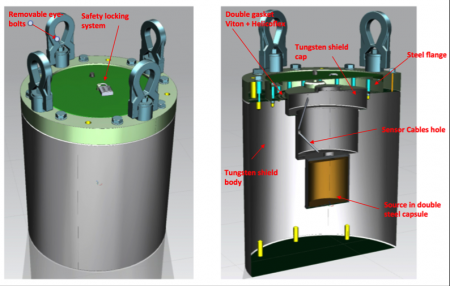
Tungsten alloy shield surrounding the CeANG (HDTAS). The cylindrical device of about 50 cm diameter and 55 cm height weights 2.3 tons.
The 144Ce antineutrino generator is a also gamma emitter and must thus be placed inside a 19 cm thick high-density (18.0 g/cm3) tungsten alloy shield (called HDTAS). This shield is providing a biological protection during all operations as well as a background suppression during the data-taking period. The CeANG will be permanently enclosed into the HDTAS to attenuate the gamma dose, dominated by the gamma ray of 2.185 MeV emitted in 0.7 % of the decays.
The alloy is composed of tungsten (95.0 %), iron (1.5 %), and nickel (3.5 %). The HDTAS is basically made of two parts. The main body is a hollow cylinder, with a lower cylindrical cavity that will accommodate the CeANG stainless steel capsule, and an upper cylindrical cavity. The upper cavity will receive the second part, which is a tungsten heavy alloy plug used to close the shielding.
Such a shielding design ensures the necessary attenuation of 2 MeV gamma ray radiation. On top of the plug will be installed a helicoflex gasket to tightly close the device. The total weight is close to 2300 kg.
Due to the heat released by the CeANG, less than 1200 W, the surface temperature of the shield will be about <80°C at the maximum activity.
The radiation dose at 1 m of the shielding will be less than 10 microSv/hour.
Safety issues are of major importance and are thus considered according to all current international standards, in relation with the safety authorities (ASN, ISPRA, Rosatom).
In the scope of the CeANG delivery, PA MAYAK is applying the following regulations:
- Regulation ISO-9978 and ISO-2919 (Radiation protection - Sealed radioactive sources – Leakage test methods).
- Regulations for the Safe Transport of Radioactive Material, IAEA Safety Standards, Safety Requirements No TS-R-1, Current Issue.
At the end of the scientific operations carried out in Italy, the sealed source will return to France, in 2019, to be disposed by the Russian supplier PA MAYAK.
In order to anticipate any difficulties in deploying this nominal recovery scheme, the CEA also fully considered an alternative disposal solution in France.

